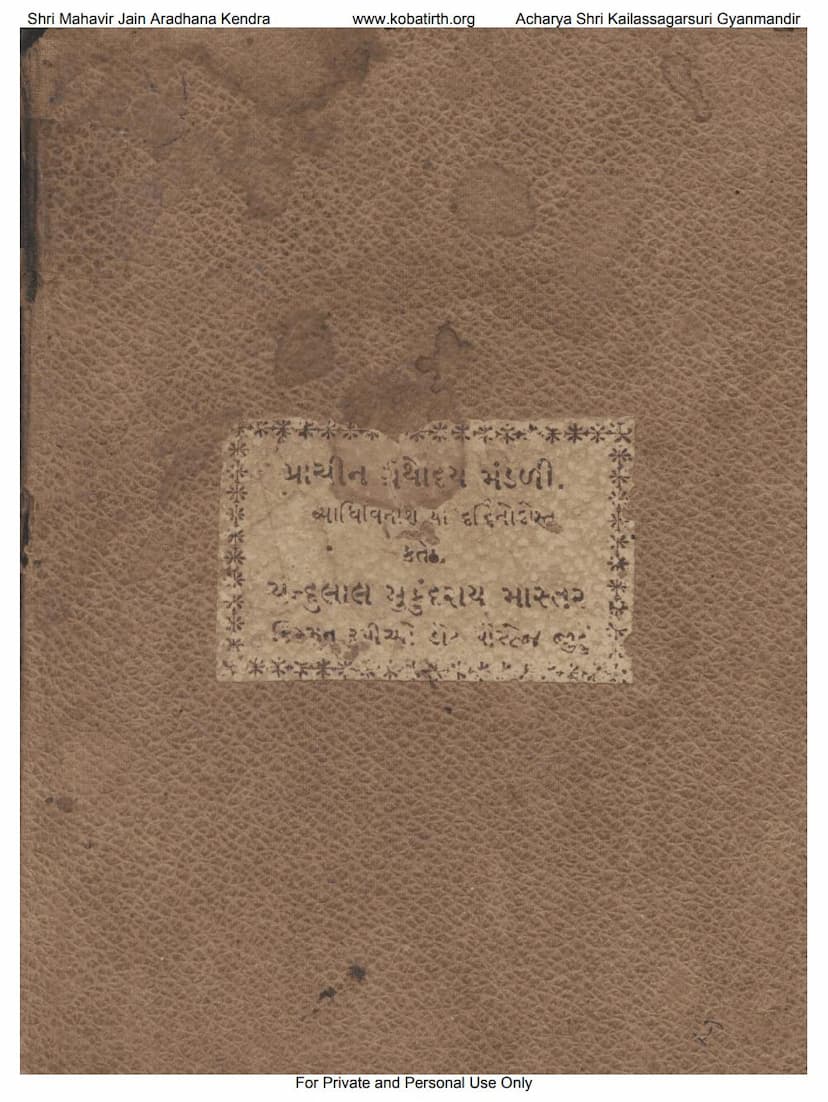Vyadhi Vinash Ya Dardino Dost
Added to library: September 2, 2025

Summary
Here's a comprehensive summary of the Jain text "Vyadhi Vinash ya Dardino Dost" by Chandulal M. Master:
Book Title: Vyadhi Vinash ya Dardino Dost (Disease Destruction or Friend of the Ailing) Author: Chandulal Mukundray Master Publisher: Ranchodlal Gangaram Year of Publication: 1888 (Samvat 1945) Language: Gujarati
Overall Purpose: This book is a comprehensive guide to health and medicine, aimed at providing practical knowledge in simple Gujarati. The author's intention is to make Ayurvedic (traditional Indian medicine) knowledge accessible to the common person, bridging the gap between complex Sanskrit medical texts and the needs of the lay reader. The book covers a wide range of diseases, their diagnosis, symptoms, causes, and remedies, emphasizing traditional Indian methods and natural remedies.
Key Themes and Content:
-
Importance of Health: The book begins by emphasizing that maintaining health is a primary duty of every living being, as health is the foundation for enjoying life and achieving prosperity. The author highlights the importance of taking care of one's body for personal well-being, the health of future generations, and a happy life.
-
Causes of Disease: The text attributes diseases to two main factors: physical and mental. It explains that both stem from imbalances in the body's three fundamental energies (doshas): Vata (wind), Pitta (bile), and Kapha (phlegm). Unhealthy diet and lifestyle are identified as primary contributors to these imbalances, leading to various ailments, some of which can become incurable over time.
-
Preventive Healthcare and Lifestyle: A significant portion of the book is dedicated to promoting a healthy lifestyle, providing guidance on:
- Air: The importance of breathing fresh, clean air, and avoiding polluted environments. It suggests specific times and types of air that are beneficial.
- Clothing: The necessity of wearing clean, well-fitting, and appropriate clothing for different seasons. It advises against tight or overly loose garments and highlights the potential harm of certain dyes.
- Hygiene: Emphasizing the importance of regular bathing, proper hair care, nail trimming, and maintaining cleanliness to prevent infections and diseases.
- Diet: Detailed explanations of the properties of various foods and their impact on the body's doshas. It stresses the importance of regular and balanced meals, including the six tastes (sweet, sour, salty, pungent, bitter, astringent).
- Sleep and Daily Routine: The book offers advice on maintaining a regular sleep schedule and balancing work with rest.
-
Diagnosis and Symptoms: The book provides detailed information on how to diagnose diseases through various methods:
- Pulse (Nadi) Examination: Describing how to check the pulse and interpret its variations to understand the patient's condition.
- Urine and Stool Examination: Explaining the significance of observing urine and stool for diagnostic clues.
- Tongue and Facial Examination: Providing insights into what the tongue and facial features can reveal about a patient's health.
- Observation of Symptoms: Detailing the specific symptoms associated with numerous diseases, categorized by the involved dosha.
-
Disease Categories and Treatments: The book systematically covers a vast array of diseases, offering traditional Ayurvedic remedies and treatments. These include:
- Fevers (Jwar): Describing various types of fevers (Vata, Pitta, Kapha, Sannipata, etc.) and their specific symptoms and treatments.
- Digestive Issues: Detailed explanations of conditions like indigestion (Ajirna), diarrhea (Atisar), dysentery (Sangrahani), hemorrhoids (Harsha), and their remedies.
- Respiratory and Circulatory Issues: Covering cough (Udharsh), asthma (Dam), tuberculosis (Kshay rog), and disorders of the blood (Raktvikar).
- Skin Diseases: Addressing conditions like itching (Khaj), ringworm (Dadra), eczema (Khajva), and others.
- Urinary and Reproductive System Disorders: Discussing issues related to urine flow (Mutrakruchh), stones (Pathri), diabetes (Madhumeh), and various female reproductive health issues (Stri Rog, Pradar, Yon Rog).
- Nervous System and Musculoskeletal Disorders: Including paralysis (Pakshaghat), joint pain (Sandhivat), and issues related to Vata aggravation.
- Infections and Contagious Diseases: Addressing smallpox (Shitala), rabies (Hadkava), and others.
- Poisoning: Providing information on antidotes and treatments for various types of poisons (Vish Prakaran).
- Mental Health: Discussing insanity (Unmad) and its different forms.
- Eye, Ear, and Mouth Diseases: Offering remedies for common ailments of these organs.
- Surgical Considerations: Touching upon conditions like fractures (Asthibhang) and descriptions of surgical instruments (Yantra).
-
Herbal and Mineral Remedies: The book lists numerous medicinal plants and their properties, explaining how to prepare and use them for various ailments. It also includes information on certain mineral-based preparations (Bhasma) but cautions about their efficacy and preparation methods, often favoring herbal treatments.
-
Ayurvedic Principles: The text adheres to core Ayurvedic principles, explaining the role of the three doshas, the six tastes, and the concept of the seasons (Ritu) influencing health and disease.
-
Practical Guidance: The author emphasizes the importance of proper diagnosis before administering treatment and encourages consultation with experienced practitioners.
-
Metaphysical and Observational Aspects: The book also includes sections on recognizing auspicious and inauspicious omens before undertaking medical practice, adding a layer of traditional belief.
Key Features:
- Simplicity of Language: The book is written in clear and simple Gujarati, making complex medical information accessible to a broad audience.
- Comprehensive Scope: It covers a vast number of diseases and treatments, acting as a mini-encyclopedia of traditional medicine.
- Emphasis on Natural Remedies: The focus is primarily on herbal and natural treatments, reflecting the Ayurvedic tradition.
- Structured Format: The book is well-organized into chapters and sections, with a detailed index to help readers navigate the content.
- Author's Intent: Chandulal Master aimed to empower individuals with knowledge of health and healing, enabling them to take better care of themselves and their families.
In essence, "Vyadhi Vinash ya Dardino Dost" is a valuable historical document and a practical guide that reflects the state of medical knowledge and practice in India during the late 19th century, presented with a Jain perspective on health and well-being.